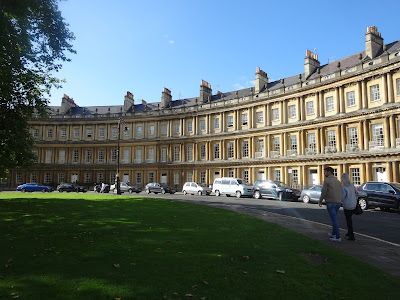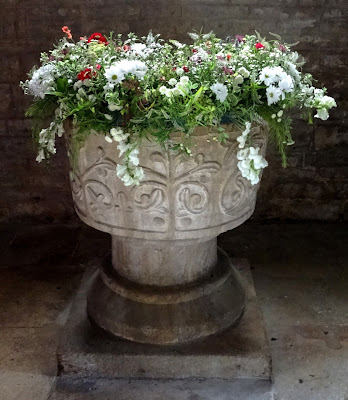We had an hour or so before our 12pm tour so Rosemary and I decided to have a look inside Bath Abbey which dates from the late 15th/early 16th centuries and was the last of England's great abbey churches to be built. Underneath the current Abbey lie the remains of the Norman Abbey and before that an Anglo Saxon convent founded in 676AD stood on the site. In 757AD a monastery was built and for a while the convent and monastery may have existed side by side. Certainly the board listing the Priors of Bath Abbey named two Abbesses - Bertana and then Bernguidis - at the top of the list..
The beautiful fan vaulted ceiling above the nave. The guide book says that the famous dandy Beau Nash is buried in the nave but other sources claim that after an elaborate funeral funded by the City Corporation he was buried in an unmarked pauper's grave which is hardly likely to be in the nave!
The Abbey is absolutely stuffed full of memorials and an amazing number of the people named on them either came from or had spent many years abroad. Rosemary and I wondered whether they had come to Bath to take the waters and had died there either in spite of or because of this! Though in all fairness to the waters of Bath a good many of them had lived to a ripe old age even by modern standards.
Prior Birde's Chantry Chapel - before the Reformation the Abbey was part of a Benedictine monastery. William Birde was Prior until his death in 1525.
Finally the view from the choir looking down the nave towards the West window.
Bath is famous for its thermal spring which produces over a million litres of water every day. It reaches the surface with a constant temperature of 45C (113F) but quickly cools to a pleasant 34C(93F). It also contains 42 different minerals and has been regarded as a healing spring since the 9th century BC - long before the Romans arrived in Britain. It was a sacred site dedicated to the Celtic goddess Sulis and the Romans combined Sulis with her Roman equivalent Minerva and built a magnificent temple and an equally magnificent bath house around the spring. The photograph shows the sacred pool of Sulis where the water rises before being channelled into the bathing pools. People would throw votive offerings, including over 12000 Roman coins, into the water and 130 lead curse tablets have also been found on the bottom of the pool. Some of the curses ask for very specific and unpleasant punishments for the person being cursed! These were all discovered when the spring was temporarily diverted in 1979/80 so that archaeological excavations could be carried out.
In case you have as much trouble spotting it as I did here it is:)
This is the Great Bath which was the centre of a large bathing complex with changing room, warm, hot and cold rooms as well as three pools for swimming. It was a centre of social life as well as a place to get clean, people played board games, gambled, ate and drank and generally had a good time. Can you spot the Roman soldier?
Perhaps he is just coming off duty and is looking for his friends:)
This isn't the first time that I've visited the Roman Baths but it's a very different place now than it was when I last saw it many years ago. A great deal of excavation has been done some of it very recent. This is the Temple of Sulis Minerva which is located I think beneath the street outside the modern entrance to the Baths. The Roman street level was much lower than it is now.
This inscribed stone pedestal stands pretty much in the place where it was found close to the altar. The inscription reads
Deae Suli
L Marcius Memor
Harusp
D D
and translates as
'For the goddess Sulis
Lucius Marcius Memor
Haruspex
Gave this gift'.
It's thought that the gift would have been a statue of some sort. Oh, you want to know what a haruspex is? He is a priest who interpreted omens by inspecting the entrails of sacrificial animals! Well, you did ask:)
There is an excellent mueum as part of the complex which has some really superb objects in it but this is the piece de resistance as far as I'm concerned - the wonderful gilded bronze head of Sulis Minerva. It was found in 1727 when workmen were digging a sewer beneath Stall St which is right outside the Roman Baths. It would have been part of the cult statue that once stood inside the Temple and the rest of it must be somewhere not too far away. Perhaps one day it will be found.
After our tour of the Baths Rosemary and I decided to wander round the streets and look at some of the wonderful architecture.It happened that our visit coincided with a Jane Austen weekend and Bath was full of people in Regency costumes - some more authentic than others:) This little group is outside the Assembly Rooms. In spite of several attempts I have never yet managed to get inside the Assembly Rooms as they have always been closed for a function or refurbishment. This was no exception as there was a wedding taking place! The Assembly Rooms opened in September 1771 and became the centre of fashionable society life in Bath during the Georgian era.There is a magnificent ballroom, a tea room and a card room and one day I hope to actually see them! This is where Beau Nash, a celebrated dandy and leader of fashion, was Master of Ceremonies. He was also a notorious gambler which is why he ended up in a pauper's grave. It does seem very odd that the Corporation were happy to pay for a splendid funeral but didn't provide money for a grave and headstone.
As you can see from the clear blue sky the weather had improved dramatically by mid afternoon.This is The Circus with its lovely Georgian town houses which were built between 1754 and 1768. Thomas Gainsborough lived at No 17 for 16 years. There are three curved sections of houses which together form a circle with three roads leading out of it. In the 1800s the central area which is now grassed over was a railed garden and the majestic London Plane trees that are growing there now must be all that is left of it.
The Royal Crescent built between 1767 and 1774 is probably the most famous landmark in Bath. No 1 Royal Crescent is now a museum showing how one of these houses might have been furnished and lived in by a wealthy 18th century owner. We didn't have time to go inside as we needed to get back to the Park and Ride bus for the hour and a quarter drive back to Birdlip. There was so much more to see and Rosemary and I are thinking we might go and spend a day there in the Spring - apart from anything else we never got to Sally Lunn's teashop!
































































